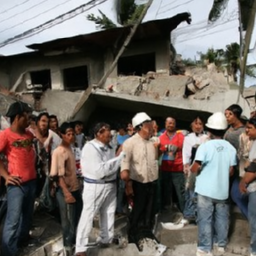A series of powerful earthquakes struck the Philippines on September 30, 2025, causing significant concern among residents and officials alike. The seismic events, which occurred in rapid succession, registered magnitudes of 6.7 and 6.8, primarily affecting Leyte Island. Fortunately, no tsunami warning was issued, allowing for a sense of relief amid the chaos. In my experience covering seismic activity in the region, the Philippines is no stranger to earthquakes due to its location along the Pacific Ring of Fire, an area known for its high seismic activity. The recent quakes, however, were particularly alarming due to their intensity and the short time frame in which they occurred. According to official reports from the Philippine Institute of Volcanology and Seismology (PHIVOLCS), the first quake struck at approximately 2:15 PM local time, followed closely by another tremor just minutes later. The earthquakes were felt across a wide area, with reports of shaking reaching as far as Cebu City and even parts of Mindanao. Eyewitness accounts indicate that buildings swayed, and many residents rushed outdoors in fear of structural collapse. As observed, the rapid succession of these quakes heightened anxiety among the populace, many of whom have experienced similar events in the past but not of this magnitude. Experts agree that the geological makeup of the Philippines contributes to the frequency and intensity of earthquakes. The country sits atop several tectonic plates, making it susceptible to seismic activity. Research confirms that the region has experienced numerous significant earthquakes throughout its history, with varying impacts on infrastructure and communities. In the aftermath of the quakes, local authorities mobilized emergency response teams to assess damage and ensure public safety. Initial reports indicated that while there were no immediate casualties, several buildings sustained structural damage, particularly in Leyte. Government data shows that emergency services were on high alert, prepared to respond to any aftershocks, which are common following significant seismic events. The absence of a tsunami warning was a critical factor in the response to these earthquakes. Regulatory agencies report that while the seismic activity was intense, it did not meet the criteria for triggering a tsunami alert. This information was crucial in preventing panic among coastal communities, allowing residents to focus on safety measures rather than evacuation. As the situation unfolded, it became clear that the earthquakes had broader implications for disaster preparedness in the region. Observations indicate that while the immediate response was effective, the events highlighted the need for ongoing education regarding earthquake safety and preparedness. Experts note that many residents may not fully understand the risks associated with living in a seismically active area, which can lead to inadequate responses during emergencies. In light of these events, there is a renewed call for improved infrastructure resilience in the Philippines. Studies show that retrofitting older buildings and enforcing stricter building codes can significantly reduce the risk of catastrophic damage during earthquakes. Professional standards require that new constructions adhere to seismic safety regulations, yet enforcement remains inconsistent in many areas. The psychological impact of such earthquakes cannot be overlooked. Many residents expressed feelings of anxiety and fear in the aftermath, a common response to experiencing significant seismic events. Mental health professionals emphasize the importance of providing support to those affected, as the emotional toll can linger long after the physical damage has been addressed. Looking ahead, experts predict that the Philippines will continue to face challenges related to seismic activity. The government and local authorities are urged to prioritize disaster preparedness initiatives, including community drills and educational programs. According to peer-reviewed research, proactive measures can significantly enhance community resilience and reduce the impact of future earthquakes. In conclusion, the recent series of earthquakes in the Philippines serves as a stark reminder of the regions vulnerability to seismic events. While the immediate response was commendable, the ongoing need for education, infrastructure improvement, and mental health support remains critical. As observed, the lessons learned from these events can help shape a more prepared and resilient society in the face of future challenges. The importance of understanding and addressing the risks associated with living in a seismically active region cannot be overstated, as it is essential for safeguarding lives and property in the years to come.
TRENDING NOW
WORLD
Global Messaging Trends: Can Local Apps Like Arattai Overtake Giants?
44% 🔥
POLITICS
Accusations fly over whether Republicans or Democrats 'own' shutdown
35% 🔥
POLITICS
Rep. Mike Haridopolos, R-Fla., talks about the government shutdown
34% 🔥
POLITICS
What happens now that the government has shut down. And, a pricing deal with Pfi...
26% 🔥
POLITICS
Married, but no connection: Reality of silent divorces in Indian homes
31% 🔥
POLITICS
Netanyahu's apology to Qatar, phone on Trump's lap: A telling White House photo
38% 🔥
MOST READ
SPORTS
Week 5 NFL odds, lines, betting picks, spreads: 2025 predictions: Model backs Sa...
55% 🔥
SPORTS
Predicting every undefeated college football team's first loss: Will anyone beat...
36% 🔥
SPORTS
Tigers Lefty Tarik Skubal Deserves Second Straight AL Cy Young Award
54% 🔥
SPORTS
Jets Get Official Braelon Allen Injury Diagnosis
61% 🔥
SPORTS
Gill: India won't be 'looking for any easy options' against West Indies
49% 🔥
SPORTS
Phil Mickelson takes a jibe at golf during friendly banter with ex-LIV Golf CEO’...
39% 🔥

